John Keats (1795-1821)
John Keats is a Romantic poet. Fascinated by Greek mythology from
childhood. Andrew Long's comments "Keats variety is so great in sonnet,
lyric, ode and in Romantic tale" Keats, Byron and Shelly were
outstanding young Romantics.
Keat's poetry with "perfect finish and melody, dramatic power and the
rapturous depth of feeling conveyed as well as in its characteristic
sensuous quality." His novel idea that "poetry exists for its own cause"
and this idea must have influenced the Roamantic movement. have influenced the Roamantic movement.
Keat's "His Last Sonnet" is an Italian Sonnet. The Octet presenting
the problem and the sestet resolving it. There's richness of imagery
quite impressive.
The Octet with images from the inanimate world and the sestet
highlighting his acceptance of the positive aspects evoking love in a
dramatic style using excellent imagery. Keat's "ode to Autumn" is an
excellent achievement completely free from the influence of "a figure of
a woman" following the observation and description of nature's
occurrences.
The opening line is one single statement. "Season of mists and mellow
fruitfulness." Keat's appropriate wording and the simple diction style,
uniqueness and using language to acquire the effect of varied seasonal
changes is highlighted in an enticing manner.
"The Red Breast whistles from a garden - Croft and gathering swallows
twitter in the skies." The clouds floating creating beautiful formation
in the "vast azure explanse" like the works of the "Heavenly creator
splashing colours in gay abandon." Symbolism, wording, imagery and the
language pattern invite the reader's attention to the nature's changing
secret.
Having refrained from the long and ceremonial address Keats laments
the end of Season's fruitfulness, carrying the perception of human
existence. Fine expression, tone and style and his poetic creativity
highlight the theme of the poem "Ripeness" which may "stand as an
analogy" to the poet's own life.
John Keat's "His Last Sonnet"; the poet's longing "for harmony
between the real and ideal world is fulfilled in the only way possible
by the last line.
"And so live ever or else swoon to death" and the poet's fulfilment
of what he is longing for "to cease to live" is stressed in an effective
manner (Angela Hussain). The reader is prepared for the "conclusion by
the word "ripening" inevitably leading to death" "His Last Sonnet" an
Italianate Sonnet conveys to the reader, a picture of his own life story
his love for Fanny Brawne and poverty and ill health stood on his way "a
reconciliation between the real and an ideal world..." (Angela Hussain).
Mrs. C. Ekanayake, Retd. Specialist Teacher Eng., St. Anne's
College, Kurunegala
|
